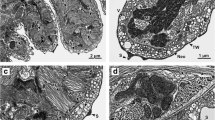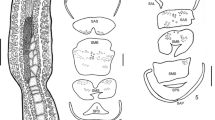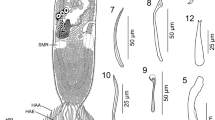Abstract
A comparative study of the haptoral morphology of three diplozoon species (Monogenea: Diplozoidae) from the gills of fish from polluted water bodies (the Obʼ River and Rybinsk Reservoir, Russia) and the unpolluted Tana Lake (Africa) has been carried out. An examination of the haptors of Paradiplozoon megan (Bychowsky et Nagibina, 1959) from ide captured in the Obʼ River and Rybinsk Reservoir and Diplozoon paradoxum von Nordmann, 1832 from bream from the same water bodies has revealed a large number of abnormalities in the attachment clamps. Different abnormalities in the structure of attachment clamps have also been found in Paradiplozoon spp. from barbels from Lake Tana, which is not exposed to industrial pollution. According to the literature data, abnormalities in the haptor structure have also been found in diplozoons from relatively clean water bodies. Abnormalities, such as the formation of rudiments of the fifth and sixth clamps, have been recorded only in clean water bodies. It is hypothesized that the pollution of water bodies is not the main cause of the formation of abnormalities in the structure of clamps; there is also a natural (“background”) frequency of occurrence of abnormalities in diplozoons.


Similar content being viewed by others
REFERENCES
Anikeeva, L.V., Influence of sewage from the Segezha Pulp and Paper Mill on the helminth fauna of Vygozero fish, Ekologiya paraziticheskikh organizmov v biogeotsenozakh Severa (Ecology of Parasitic Organisms in Biogeocenoses of the North), Petrozavodsk: Karel. Fil. Akad. Nauk SSSR, 1982, pp. 83–94.
Anikeeva, L.V., The use of helminthological data in assessing the state of the reservoir, Ekologiya paraziticheskikh organizmov v biogeotsenozakh Severa (Ecology of Parasitic Organisms in Biogeocenoses of the North), Petrozavodsk: Karel. Fil. Akad. Nauk SSSR, 1982a, pp. 72–83.
Bovet, J., Contribution a la morphologie et a la biologie de Diplozoon paradoxum v. Nordmann, 1832, Bull. Soc. Neuchatel. Sci. Nat., 1967, vol. 3, pp. 64–159.
Brázová, T., Hanzelová, V., and Miklisová, D., Bioaccumulation of six PCB indicator congeners in a heavily polluted water reservoir in Eastern Slovakia: tissue-specific distribution in fish and their parasites, Parasitol. Res., 2012, vol. 111, pp. 779–786. https://doi.org/10.1007/s00436-012-2900-3
Chuiko, G.M., Zakonnov, V.V., Morozov, A.A., Brodskii, E.S., Shelepchikov, A.A., and Feshin, D.B., Spatial distribution and qualitative composition of polychlorinated biphenils and organochlorine pesticides in bottom sediments and bream (Abramis brama L.) from the Rybinsk reservoir, Inland Water Biol., 2014, vol. 3, no. 2, pp. 193–202. https://doi.org/10.1134/S199508291002015X
Dubini, V.B., The effect of water salinization in the Malyi Uzen’ River on the parasite fauna of fishes inhabiting the river, Zool. Zh., vol. 27, no. 4, pp. 335–342.
Dušek, L., Gelnar, M., and Šebelova, Š., Biodiversity of parasites in a freshwater environment with respect to pollution: metazoan parasites of chub (Leuciscus cephalus L.) as a model for statistical evaluation, Int. J. Parasitol., 1998, vol. 28, pp. 1555–1571.
Dzika, E., Deformations of the attachment organ in Diplozoidae (Palombi, 1949) (Monogenea), Wiad. Parazytol., 2002, vol. 48, no. 1, pp. 69–77.
Dzika, E., Kuształa, A., and Kuształa, M., Parasites of carp bream, Abramis brama, from Lake Jamno, Poland, Helminthologia, 2007, vol. 44, pp. 222–225.
Erasmus, J.H., Wepener, V., Nachev, M., Zimmermann, S., Malherbe, W., Sures, B., and Smit, N.J., The role of fish helminth parasites in monitoring metal pollution in aquatic ecosystems: a case study in the world’s most productive platinum mining region, Parasitol. Res., 2020, vol. 119, pp. 2783–2798. https://doi.org/10.1007/s00436-020-06813-1
Flerov, B.A., Ecological situation at the Rybinsk Reservoir as a result of an accident at the treatment facilities of Cherepovets city in 1987, Vliyanie stokov Cherepovetskogo promyshlennogo uzla na ekologicheskoe sostoyanie Rybinskogo vodokhranilishcha (Influence of Effluents from the Cherepovets Industrial Hub on the Ecological State of the Rybinsk Reservoir), Rybinsk, 1990, pp. 3–11.
German, A.V., Zakonnov, V.V., and Mamontov, A.A., Organochlorine compounds in bottom sediments, benthos, and fish in the Volga pool of the Rybinsk Reservoir, Water Resour., 2010, vol. 37, no. 1, pp. 84–88.
Gheorgiu, C., Marcogliese, D.J., and Scott, M., Concentration-dependent effects of waterborne zinc on population dynamics of Gyrodactylus turnbulli (Monogenea) on isolated guppies (Poecilia reticulata), Parasitology, 2006, vol. 132, pp. 225–232. https://doi.org/10.1017/S003118200500898X
Gilbert, B.M. and Avenant-Oldewage, A., Effects of altered water quality and trace elements on the infection variables of Paradiplozoon ichthyoxanthon (Monogenea: Diplozoidae) from two sites in the Vaal River system, South Africa, Acta Parasitol., 2016, vol. 61, no. 1, pp. 52–62. https://doi.org/10.1515/ap-2016-0005
Goshu, G., Koelmans, A.A., and Klein, J.J.M., Water quality of Lake Tana basin, upper Blue Nile, Ethiopia: A review of available data, Soc. Ecol. Syst. Dyn., 2017, pp. 127–141.
Grebenjuk, L.P. and Tomilina, I.I., Morphological deformations of hard-chitinized mouthpart structures in larvae of the genus Chironomus (Diptera, Chironomidae) as the index of organic pollution in freshwater ecosystems, Inland Water Biol., 2014, vol. 7, no. 3, pp. 273–285. https://doi.org/10.1134/S1995082914030092
Khotenovskii, I.A., Podotryad Octomacrinea Khotenovsky (Suborder Octomacrinea Khotenovsky), Leningrad: Nauka, 1985.
Koskivaara, M. and Valtonen, E.T., Paradiplozoon homoion (Monogenea) and some other gill parasites on roach Rutilus rutilus in Finland, Aqua Fenn., 1991, vol. 21, pp. 37—143.
Kozlovskaya, V.I., Pavlov, D.F., Chuiko, G.M., Khal’ko, V.V., Vinnikov, Yu.Ya., and Anokhin, S.V., The influence of pollutants on the condition of fish in the Sheksninsky reach of the Rybinsk reservoir, Vliyanie stokov Cherepovetskogo promyshlennogo uzla na ekologicheskoe sostoyanie Rybinskogo vodokhranilishcha (Influence of Wastewater from the Cherepovets Industrial Hub on the Ecological State of the Rybinsk Reservoir), Rybinsk, 1990, pp. 123–143.
Kuperman, B.I., Parasites as bioindicators of the pollution of water bodies, Parazitologiya, 1992, vol. 26, no. 6, pp. 479–482.
Matei, V.E., Zhabry presnovodnykh kostistykh ryb: morfofunktsional’naya organizatsiya, adaptatsiya, evolyutsiya (Gills of Freshwater Bony Fish: Morphofunctional Organization, Adaptation, Evolution), Saint-Petersburg: Nauka, 1996.
Moskovchenko, D.V. and Babushkin, A.G., Oil pollution of surface waters on the territory of KMAD-Yugra, Ekol. Prom. Ross., 2014, no. 4, pp. 34–38. https://doi.org/10.18412/1816-0395-2014-4-34-38
Nakhshina, E.P., Heavy metals in the “water - bottom sediments” system of reservoirs, Gidrobiol. Zh., 1985, vol. 21, no. 2, pp. 80–90.
Nikanorov, A.M., Khoruzhaya, T.A., Brazhnikova, L.V., and Zhulidov, A.M., Monitoring kachestva vod: Otsenka toksichnosti (Water Quality Monitoring: Toxicity Assessment), Saint-Petersburg: Gidrometeoizdat, 2000.
Oliver, G., Observations sur quelques poissons des eaux douces et saumâtres des Pyrénées-Orientalis, Vie et Milieu, in Observatoire Océanologique – Laboratoire Arago, 1970, vol. 21, pp. 199–207.
Oliver, G. and Reichenbach-Klinke, H.H., Observations sur le genre Diplozoon von Nordmann, 1832 en Languedoc-Roussillon, Ann. Parasitol. Hum. Comp. (Paris), 1973, vol. 48, no. 3, pp. 447–456.
Osmanov, S.O. and Yusupov, O., Influence of salinization of the Aral Sea on the parasite fauna of fish, Parazitologicheskii sbornik (Parasitological Collection), vol. 33, Leningrad: Nauka, 1985, pp. 14–43.
Paperna, I., New species of Monogenea (Vermes) from African freshwater fish. A preliminary report, Rev. Zool. Bot. Afr., 1973, vol. 87, pp. 505–518.
Přikrylová, I., Mašová, Š., Gelnar, M., Matla, M.M., Tavakol, S., and Luus-Powell, W.J., Redescription of the genus Afrodiplozoon Khotenovski, 1981 and its only known species Afrodiplozoon polycotyleus (Paperna, 1973) (Monogenea: Diplozoidae) using a combined multidisciplinary approach, Parasitol. Int., 2018, vol. 67, no. 2, pp. 245–252. https://doi.org/10.1016/j.parint.2017.11.008
Roitman, V.A. and Sokolov, S.G., Teratological changes in parasites, representatives of the genus Gyrodactylus (Monogenea), of goldfish (Carassius carassius gibelio), Biol. Vnutr. Vod, 1998, no. 1, pp. 67–73.
Russkikh, I.V., Serebrennikova, O.V., Strel’nikova, E.B., Kadychagov, P.B., and Ivanov, A.A., The identification of pollutants in the Ob river near oil production areas, Zh. Sib. Fed. Univ., Khim., 2020, vol. 13, no. 2, pp. 157–166. https://doi.org/10.17516/1998-2836-0171
Šebelová, Š., Kuperman, B., and Gelnar, M., Abnormalities of the attachment clamps of representatives of the family Diplozoidae, J. Helminthol., 2002, vol. 76, no. 3, pp. 249–259. https://doi.org/10.1079/JOH2002133
Sures, B. and Taraschewski, H., Cadmium concentration in two adult acanthocephalans, Pomphorhynchus laevis and Acanthocephalus lucii, as compared with their fish hosts and cadmium and lead levels in larvae of A. lucii as compared with their crustacean host, Parasitol. Res., 1995, vol.81, no. 6, pp. 494–497.
Tomilina, I.I., Grebenyuk, L.P., and Chuiko, G.M., Toxicological and teratological assessment of bottom sedimentes from the Rybinsk reservoir, Inland Water Biol., 2011, vol. 4, no. 3, pp. 373–382. https://doi.org/10.1134/S1995082911030187
Ulbrich, B. and Stahlmann, R., Developmental toxicity of polychlorinated biphenils (PCBs): a systematic review of experimental data, Arch. Toxicol., 2004, vol. 78, pp. 252–268.
Wondim, Y.K., Water quality status of Lake Tana, Ethiopia, Civ. Environ., 2016, vol. 8, no. 9, pp. 39–51.
Zargar, U.R., Chishti, M.Z., Yousuf, A.R., and Fayaz, A., Infection level of monogenean gill parasite, Diplozoon kashmirensis (Monogenea, Polyopisthocotylea) in the Crucian Carp, Carassius carassius from lake ecosystems of an altered water quality: What factors do have an impact on the Diplozoon infection?, Vet. Parasitol., 2012, vol. 189, nos. 2–4, pp. 218–226. https://doi.org/10.1016/j.vetpar.2012.04.029
Zharikova, T.I., Izyumova, N.A., and Stepanova, M.A., Effect of industrial and domestic wastewater on ectoparasites of the bream of the Kuibyshev reservoir (Volga-Kama reach), Biol. Vnutr. Vod., 1992, no. 95, pp. 56–63.
Zharikova, T.I., The effect of anthropogenic pollution of reservoirs on bream (Abramis brama) ectoparasites, Zool. Zh., 1993., vol. 72, no. 2, pp. 73–83.
Zhokhov, A.E. and Tyutin, A.V., Parasitic fauna of fishes in the conditions of acidification of lakes. Structure and functioning of acid lake ecosystems, Tr. Inst. Biol. Vnutr. Vod Ross. Akad. Nauk, 1994, vol. 70, no. 73, pp. 186–201.
Funding
This study was supported by the government of Tyumen oblast as part of project no. 89-DON (2) of the West Siberian Interregional Scientific and Educational Center.
Author information
Authors and Affiliations
Corresponding author
Ethics declarations
The authors declare that they have no conflict of interests.
Additional information
Translated by D. Zabolotny
Rights and permissions
About this article
Cite this article
Zhokhov, A.E., Pugacheva, M.N. & Zhigileva, O.N. Is Water Pollution the Only Cause of Abnormalities of the Attachment Clamps of Monogeneans (Diplozoidae), a Parasite of Freshwater Fishes?. Contemp. Probl. Ecol. 15, 459–466 (2022). https://doi.org/10.1134/S1995425522050134
Received:
Revised:
Accepted:
Published:
Issue Date:
DOI: https://doi.org/10.1134/S1995425522050134




